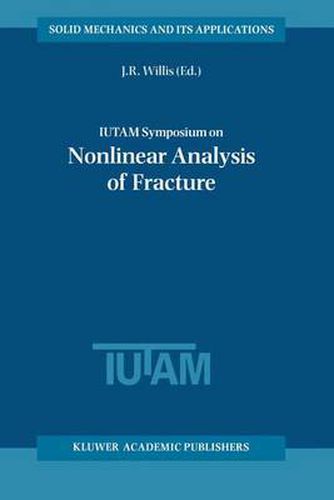Readings Newsletter
Become a Readings Member to make your shopping experience even easier.
Sign in or sign up for free!
You’re not far away from qualifying for FREE standard shipping within Australia
You’ve qualified for FREE standard shipping within Australia
The cart is loading…






This title is printed to order. This book may have been self-published. If so, we cannot guarantee the quality of the content. In the main most books will have gone through the editing process however some may not. We therefore suggest that you be aware of this before ordering this book. If in doubt check either the author or publisher’s details as we are unable to accept any returns unless they are faulty. Please contact us if you have any questions.
This volume constitutes the Proceedings of the IUTAM Symposium on ‘Nonlinear Analysis of Fracture’, held in Cambridge from 3rd to 7th Septem ber 1995. Its objective was to assess and place on record the current state of understanding of this important class of phenomena, from the standpoints of mathematics, materials science, physics and engineering. All fracture phenomena are nonlinear; the reason for inclusion of this qualification in the title was to reflect the intention that emphasis should be placed on distinctive aspects of nonlinearity, not only with regard to material consti tutive behaviour but also with regard to insights gained, particularly from the mathematics and physics communities, during the recent dramatic ad vances in understanding of nonlinear systems in general. The expertise represented in the Symposium was accordingly very wide, and many of the world’s greatest authorities in their respective fields participated. The Symposium remained focussed on issues of practical significance for fracture phenomena, with concentration on aspects that are still im perfectly understood. The most significant unifying issue in this regard is that of scale: this theme was addressed from several perspectives. One important aspect is the problem of passing information on one scale up or down, as an input for analysis at another scale. Although this is not always the case, it may be that the microscopic process of fracture is understood in some particular class of materials.
$9.00 standard shipping within Australia
FREE standard shipping within Australia for orders over $100.00
Express & International shipping calculated at checkout
This title is printed to order. This book may have been self-published. If so, we cannot guarantee the quality of the content. In the main most books will have gone through the editing process however some may not. We therefore suggest that you be aware of this before ordering this book. If in doubt check either the author or publisher’s details as we are unable to accept any returns unless they are faulty. Please contact us if you have any questions.
This volume constitutes the Proceedings of the IUTAM Symposium on ‘Nonlinear Analysis of Fracture’, held in Cambridge from 3rd to 7th Septem ber 1995. Its objective was to assess and place on record the current state of understanding of this important class of phenomena, from the standpoints of mathematics, materials science, physics and engineering. All fracture phenomena are nonlinear; the reason for inclusion of this qualification in the title was to reflect the intention that emphasis should be placed on distinctive aspects of nonlinearity, not only with regard to material consti tutive behaviour but also with regard to insights gained, particularly from the mathematics and physics communities, during the recent dramatic ad vances in understanding of nonlinear systems in general. The expertise represented in the Symposium was accordingly very wide, and many of the world’s greatest authorities in their respective fields participated. The Symposium remained focussed on issues of practical significance for fracture phenomena, with concentration on aspects that are still im perfectly understood. The most significant unifying issue in this regard is that of scale: this theme was addressed from several perspectives. One important aspect is the problem of passing information on one scale up or down, as an input for analysis at another scale. Although this is not always the case, it may be that the microscopic process of fracture is understood in some particular class of materials.